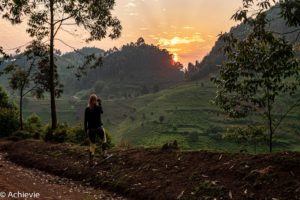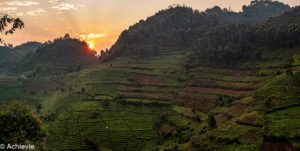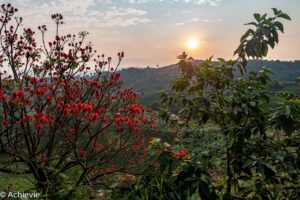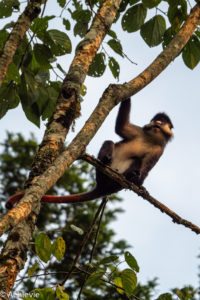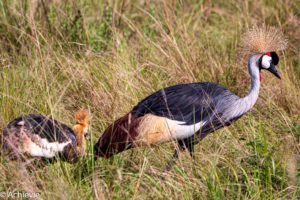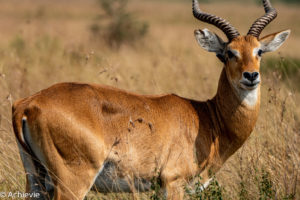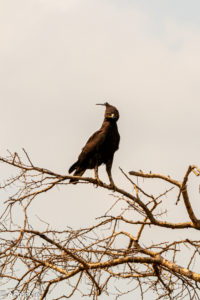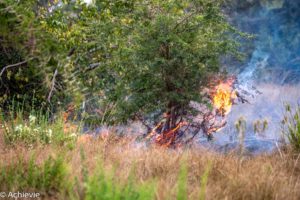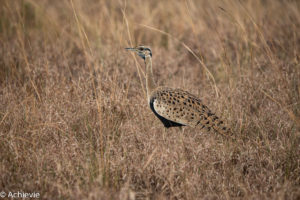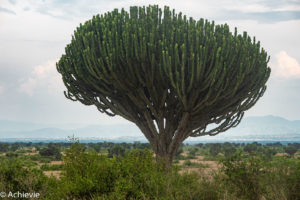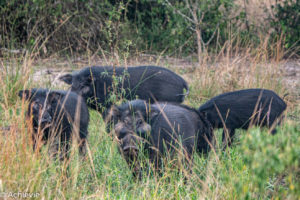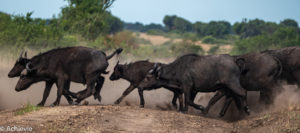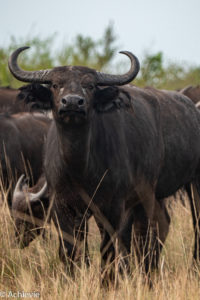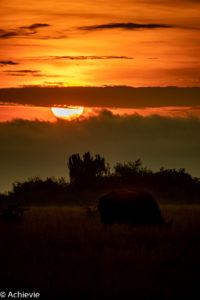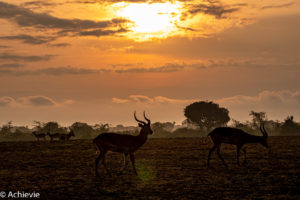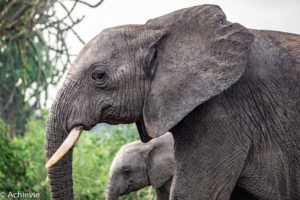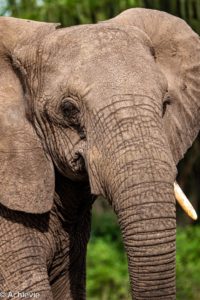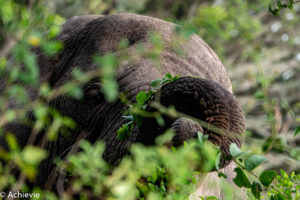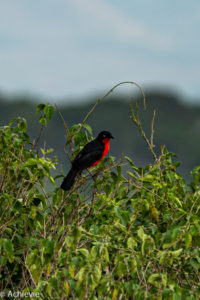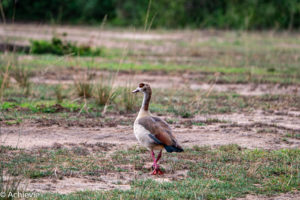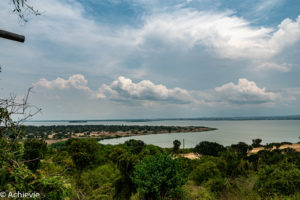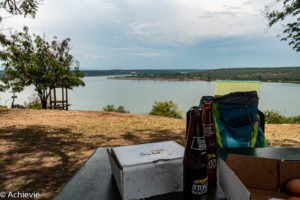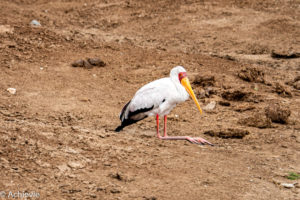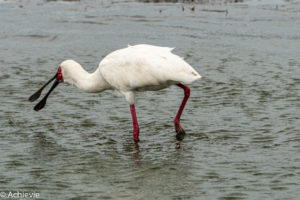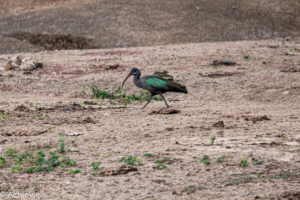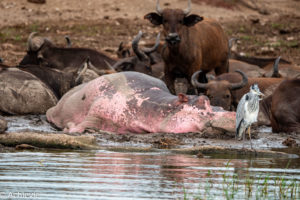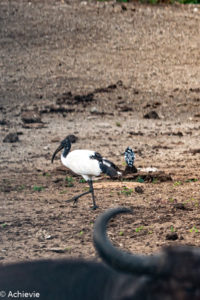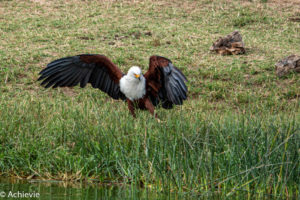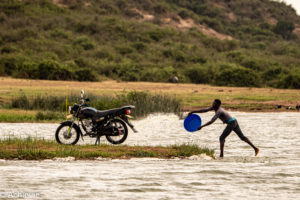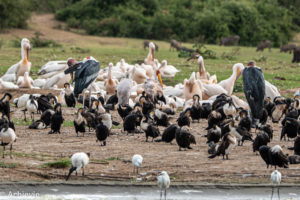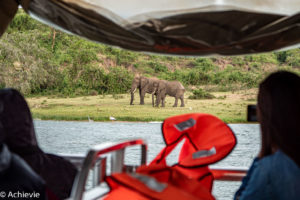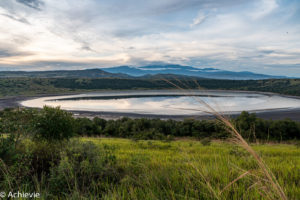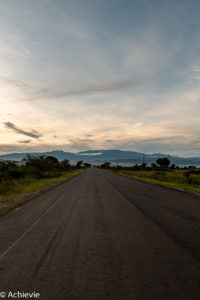Getting there
On the morning after our Gorilla experience, we headed over to Queen Elisabeth National park. We left at around 8am and it was getting sunny that morning, so we had beautiful views driving further through the National Park. The sun was getting through the misty clouds and was lightening up the valley, slowly warming up the morning’s frisky air.
We were also incredibly lucky seeing the red-tailed monkey (the last one on our list!), sitting high up in the trees and having leaves falling on the ground (that’s how we spotted them). Check!
As we were coming from Bwindi National Park, we took the road over Bugiri, Ntungamo and Kihihi. The roads are pretty bad, very bumpy for about 15km coming out of the National Park and passing some more developed villages.
We also saw a lot of children excitingly waving at us as we drove by, handing them out some balloons, which seemed to make them very happy.
Searching for the tree-climbing lions
The Ishasha sector is the first sector of the second largest National Park of Uganda that you cross, coming in from Bwindi. It’s famous for its tree-climbing lions. They say it’s a rarity in Africa. They are typically found in fig and Acacia trees, no matter what time of the day.
We arrived in the Ishasha sector around 10.15am and started our search, hoping for the best. At the Ishasha gate, we paid our entrance fees for 2 days, including the fee for the car. We also bought the map of the park (only 30.000 shilling), as this indicates the trees typically visited by the lions.
There’s two circuits in the Ishasha sector – the Northern and the Southern circuit. As the Southern circuit passes through Ugandan Kob breeding area, this is the most beneficial one for lion spotting. The roads of the Southern circuit on the other hand are less ideal to say the least, so be aware when it has rained – that can get pretty tricky. We hadn’t had any rain and it was difficult enough to navigate the numerous deep potholes.
We searched for all trees – the ones indicated as trees visited by lions and even others – just to be sure – but we didn’t see any lions. Disappointed. We asked two other safari vans and they hadn’t seen any either – apparently no lions had been spotted for days now…. Cats…
Lunch in style
After our unfruitful search for tree-climbing lions, it was time for lunch. We went for Ishasha Wilderness Camp, indicated on the map as an upper-market lodge, so we thought we could easily get some lunch there (leveraging on our experiences in South Africa). When we arrived at the gate and explained what we were looking for, the guard said he would ask the manager. Another guy came, confirming they needed to check with the manager. Apparently it’s not common to just order lunch, if you don’t stay at the lodge. We were able to get a table tough, and ordered a tasty quiche and feta pie, followed by a fruit salad.
It’s a great location to enjoy lunch, so if you have time and haven’t foreseen anything, this is a place to go (if they can squeeze you in).
Funny detail – when being at Ishasha Wilderness Camp, make sure to check out the bathroom. They’re quite original!
Exploring the Kasenyi plains
The Kasenyi plains are the other area to spot lions, but not in trees. So that’s where we were headed to in the late afternoon of our first day. There’s again 2 circuits – the Northern one, where the Kob mating grounds are and the Southern area. We did the Southern circuit first (so late afternoon). The idea was to do the outside track first and then work our way back through the inside tracks, but that didn’t turn out as planned. As we already saw in Lake Mburo National Park, the signs indicating the tracks are not the best. Looked like we got stuck on the Janet track. Finally, with the use of the GPS we were able to get back to Simba Safari Camp in time.
What we saw that afternoon: Giant forest hog, Ugandan kob, warthogs, waterbuck and buffalo. No lions…
Northern Kasenyi Plains
The next morning we got out of bed in time in order to get at the Kasenyi gate by 7am, so we were one of the first to get in. The paperwork went pretty smoothly this time, as we had already registered the day before. Right before us a safari van with guide entered, so we thought it would be wise to follow him for a while, hoping this would increase our chances to spot lions. Right after us there was another safari van, so now we had two to help us find our predators. It would turn out – unfortunately – that it wouldn’t help… Lions would not show themselves to us for the entire vacation – bummer.
But luckily, there’s other beauty to enjoy – how can it not be – in such a magical place as this? The weather conditions were perfect: the sun was breaking through the misty clouds, shining an orange glow over the savannah. The air still crispy. The sounds of birds and all other sorts of wildlife getting louder as the daylight expands. Love it.
The Northern plains were on the agenda this morning – which we did from west to east. This took us about 3,5 hours. Again – not sure which tracks we exactly did. We did stop at a part where other safari trucks were parked and people were looking at the hippos in the water.
We saw the usual: Ugandan kob, warthogs, waterbuck, buffalo and… elephant. Quite suddenly – a whole troop. We took the time to study their behavior and take pictures of course. It’s the only time that we were actually not alone, but together with about 3 or 4 or trucks.
Mweya Peninsula
As we were planning to do the boat tour on the Kazinga Channel in the afternoon, we wanted to make reservations in time. So we drove to the Mweya Safari Lodge on the Mweya Peninsula, where bookings can be made. The drive over there (through Katunguru gate) was pretty dull – literally no wildlife spotted (except for a baboon).
Arrived at the Mweya Safari Lodge, there were 2 options for the afternoon boat tour: a tour at 2pm and one at 4pm. As the one at 2pm was already fully booked, our options were limited… As it was only about 11am at that time, we had some time to kill. We started with drinks on the veranda of the Mweya Safari Lodge, offering splendid views over the peninsula. The pineapple-ginger mocktail is recommended.
After the drinks, we got to Tibo restaurant, a little further (not part of the hotel), to eat our lunch (as we had gotten lunch boxes from Simba Safari Camp, not knowing where we would end up). Some tables were set outside, again offering great views over the river. Ideal, with a Stoney ginger beverage as drinks.
And then the idea was to take a nap in the car, as we were both getting tired from the early wake up. There was no way we could make it to Simba Safari Camp and back, so that was the only option. It would turn out to be impossible. First we tried right by the restaurant, parking the car under a tree, so that we were in the shade. With the windows open, the breeze setting in from time to time was perfect. But then a ranger truck came up, parking exactly next to us, of whom 3 got out and stayed right beside the car, chatting along. No way we would get to sleep with that noise. So we drove a little further to a camp site. Not a lot of shade, but luckily clouds were rolling in. Again, with the breeze through the open windows: perfect. After about 10 minutes (not even), the relaxing sound of the birds around us turned into something a lot less pleasant. Think they smelled the sandwiches in our car. They started jumping around on top and on the side of the car, trying to get in through the rear back windows which were slightly open. We scared them away a few times, but they wouldn’t back off. After a while we gave up and got back out of the car to go to the bathroom – that’s when we saw we were also surrounded by 3 waterbucks and a warthog. And there were two other warthogs laying in what looked like a coma – under one of the bushes. Compared to us, they didn’t have an issue catching sleep, apparently…
Boat tour on the Kazinga Channel
The boats leaving from the jetty at Mweya Safari Lodge are double-deckers. I had expected we would be getting into a canoe type of boat with a motor, so that we were on the same level as the wildlife. We had seen those kinds of boats starting from the middle of the Channel – I think operated by locals. As it’s quite a ride from the Mweya Peninsula, not sure where these boats are exactly going.
So, initially somewhat disappointed about the type of boat, like everyone we started on top, as that offered the best views leaving from the jetty and going to the opposite side of the Channel, where the actual wildlife viewing was taking place.
It wouldn’t take long before we went down to the lower deck. Although we had seen all of these animals before, it’s different as you can get really close to them and they hardly move. There’s also a bunch of birds which we hadn’t seen yet, or at least where it was very difficult to get a good picture. Now, this went a lot easier. You can get really close too, so ideal for close-ups.
We saw lots of buffalo, hippo (both in and out of the water), warthogs, Nile crocodiles, hadada and sacred ibis, saddle-billed stork, pied kingfisher, hamerkop, spoonbill, pelicans, cormorant, marabou stork and many others. And when we got back to the jetty (and the boat was on the other side of the Channel again), we suddenly saw two elephants showing up and gently making their way to the water to get a drink. Ideal end.
This trip is regarded as one of the highlights of the park and have to admit we very much enjoyed it. It lasts for 1h45 (because you actually only leave at 4.15 instead of 4) and they tell you more about the Channel and the wildlife as you progress. Great end of the day and well in time before the closing of the gate at 7pm.
Craters
We didn’t do the Crater drive at the Explosion Craters area (North) or Bunyaraguru Crater Field (West). But we passed one of the crater lakes on our way back from Mweya to Simba Safari Camp (through the road from Katwe to Kasenyi gate) and it was pretty neat. So if you have time to spare, I think a good option to explore.
Make sure to pay attention to the high mountains in the back and the mist soaking them up as the evening progresses and you drive on the main road up North.
Other Countries we visited
Have a look at the other countries we ‘achievied’ to visit, and other Achievies…

